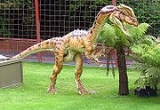
Dilophosauridae
Encyclopedia
Dilophosauridae is a family
of early carnivorous dinosaur
s. They are well-known for their distinctive head crests, which were probably used for mating displays, or to intimidate rivals. The family was proposed by Alan Charig
and Andrew Milner in 1990 to contain only the type genus, Dilophosaurus
. Other genera, such as Zupaysaurus
and Dracovenator
, have since been assigned to this family, though the group has never been given a phylogenetic definition and is not currently a clade. Some studies have suggested that there was a natural group of medium-sized crested theropods
which included Dilophosaurus as well as Dracovenator, Cryolophosaurus
, and "Dilophosaurus" sinensis, though it has not been formally named Dilophosauridae. While traditionally assigned to the superfamily Coelophysoidea
, these analyses suggest that dilophosaurids may have been more closely related to the group Tetanurae
, comprising the more advanced megalosaurs, carnosaurs and coelurosaurs
.
outlines the relationships of Dilophosaurus and its close relatives as recovered by the 2007 analysis of Smith, Makovicky, Pol, Hammer, and Currie.
Family (biology)
In biological classification, family is* a taxonomic rank. Other well-known ranks are life, domain, kingdom, phylum, class, order, genus, and species, with family fitting between order and genus. As for the other well-known ranks, there is the option of an immediately lower rank, indicated by the...
of early carnivorous dinosaur
Dinosaur
Dinosaurs are a diverse group of animals of the clade and superorder Dinosauria. They were the dominant terrestrial vertebrates for over 160 million years, from the late Triassic period until the end of the Cretaceous , when the Cretaceous–Paleogene extinction event led to the extinction of...
s. They are well-known for their distinctive head crests, which were probably used for mating displays, or to intimidate rivals. The family was proposed by Alan Charig
Alan J. Charig
Alan Jack Charig was an English palaeontologist and writer who popularised his subject on television and in books at the start of the wave of interest in dinosaurs in the 1970s....
and Andrew Milner in 1990 to contain only the type genus, Dilophosaurus
Dilophosaurus
Dilophosaurus was a theropod dinosaur from the Sinemurian stage of the Early Jurassic Period, about 193 million years ago. The first specimens were described in 1954, but it was not until over a decade later that the genus received its current name...
. Other genera, such as Zupaysaurus
Zupaysaurus
Zupaysaurus is a genus of early theropod dinosaur living during the Rhaetian stage of the Late Triassic to Hettangian stage of the Early Jurassic of what is now Argentina. Although a full skeleton has not yet been discovered, Zupaysaurus can be considered a bipedal predator, up to 4 meters ...
and Dracovenator
Dracovenator
Dracovenator is the name of a genus of dinosaur from the Early Jurassic. It was a theropod which lived in what is now South Africa.The type species, Dracovenator regenti, was formally described by A.M. Yates in 2006. The genus name is a contraction of the Latin draco, "dragon", and venator, "hunter"...
, have since been assigned to this family, though the group has never been given a phylogenetic definition and is not currently a clade. Some studies have suggested that there was a natural group of medium-sized crested theropods
Theropoda
Theropoda is both a suborder of bipedal saurischian dinosaurs, and a clade consisting of that suborder and its descendants . Dinosaurs belonging to the suborder theropoda were primarily carnivorous, although a number of theropod groups evolved herbivory, omnivory, and insectivory...
which included Dilophosaurus as well as Dracovenator, Cryolophosaurus
Cryolophosaurus
Cryolophosaurus was a large theropod dinosaur, with a crest on its head that looked like a Spanish comb. Due to the resemblance of this feature to Elvis Presley's pompadour haircut from the 1950s, this dinosaur was at one point informally known as "Elvisaurus".Cryolophosaurus was excavated from...
, and "Dilophosaurus" sinensis, though it has not been formally named Dilophosauridae. While traditionally assigned to the superfamily Coelophysoidea
Coelophysoidea
Coelophysoids were common dinosaurs of the Late Triassic and Early Jurassic periods. They were widespread geographically, probably living on all continents. Coelophysoids were all slender, carnivorous forms with a superficial similarity to the coelurosaurs, with which they were formerly...
, these analyses suggest that dilophosaurids may have been more closely related to the group Tetanurae
Tetanurae
Tetanurae, or "stiff tails", is a clade that includes most theropod dinosaurs, as well as birds. Tetanurans first appear during the early or middle Jurassic Period.-Definition:...
, comprising the more advanced megalosaurs, carnosaurs and coelurosaurs
Coelurosauria
Coelurosauria is the clade containing all theropod dinosaurs more closely related to birds than to carnosaurs. In the past, it was used to refer to all small theropods, although this classification has been abolished...
.
Phylogeny
The following cladogramCladogram
A cladogram is a diagram used in cladistics which shows ancestral relations between organisms, to represent the evolutionary tree of life. Although traditionally such cladograms were generated largely on the basis of morphological characters, DNA and RNA sequencing data and computational...
outlines the relationships of Dilophosaurus and its close relatives as recovered by the 2007 analysis of Smith, Makovicky, Pol, Hammer, and Currie.

